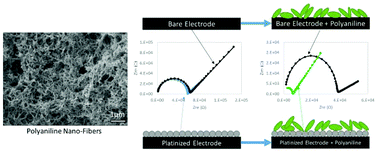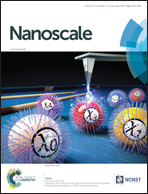Metal–polymer interface influences apparent electrical properties of nano-structured polyaniline films†
Abstract
The interface between the conductive polymer, polyaniline (PAn-Cl), and gold, platinum, or an interceding layer of electrodeposited platinum on gold or platinum, markedly influences the apparent electrical properties and the electronic to ionic transition in physiological buffers. Polyester-supported, sputter-deposited gold and platinum thin films were laser patterned to yield co-planar Thin Film Electrodes (TFEs) suitable for platinization and deposition of PAn-Cl nanofibers. Electrodeposition of platinum from chloroplatinic acid (50 mC cm−2) onto gold produced larger feature sizes and larger surface roughness (23.5 nm) when compared to platinization of platinum (15.2 nm) and both similarly reduced interfacial impedance in water and physiologically relevant buffers, PBS and HEPES. UV-Vis characterization produced absorption edges (DI water 2.36 eV, PBS 2.64 eV, and HEPES 2.66 eV) reflective of the ionic strength of the medium. Thin films (23 ± 2 μm) of PAn-Cl nanofibers were deposited onto Au, Pt, Au|Pt, Pt|Pt TFEs and each characterized by Electrical Impedance Spectroscopy (EIS) over the range 106–10−1 Hz at RT in air, DI water, PBS, and HEPES buffers and by multiple scan rate cyclic voltammetry (MSRCV) in PBS. Platinized gold and platinized platinum decorated with PAn-Cl behaved quite differently in these test environments confirming a role for the contacting surface roughness/nano-topography in influencing apparent electrical properties. Equivalent circuit modeling of EIS data revealed a modified Randles circuit (R(QR)) of low chi-square values (<0.05) that rationalized the capacitance and membrane resistance and confirmed that platinization of gold served to increase the PAn-Cl apparent resistance while platinization of platinum served to decrease the PAn-Cl apparent resistance.



 Please wait while we load your content...
Please wait while we load your content...